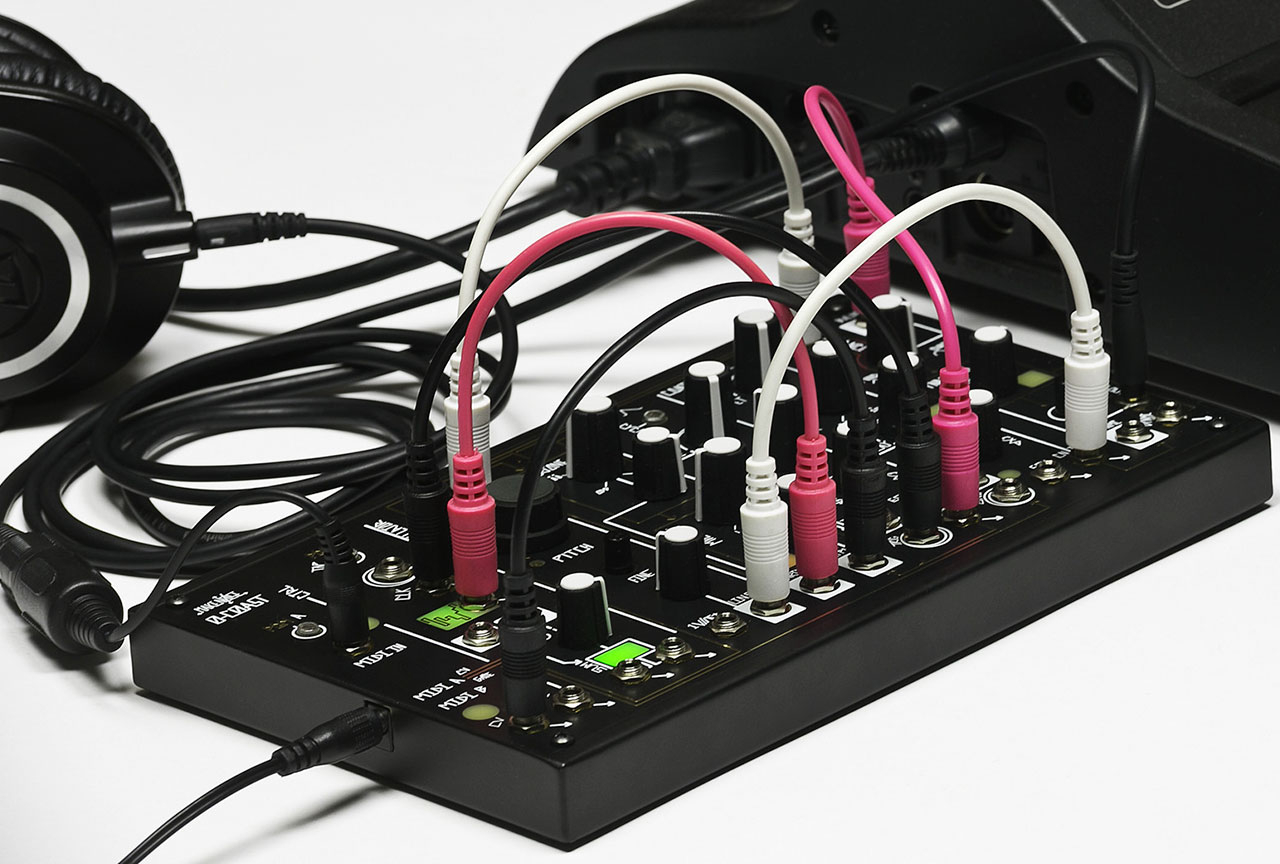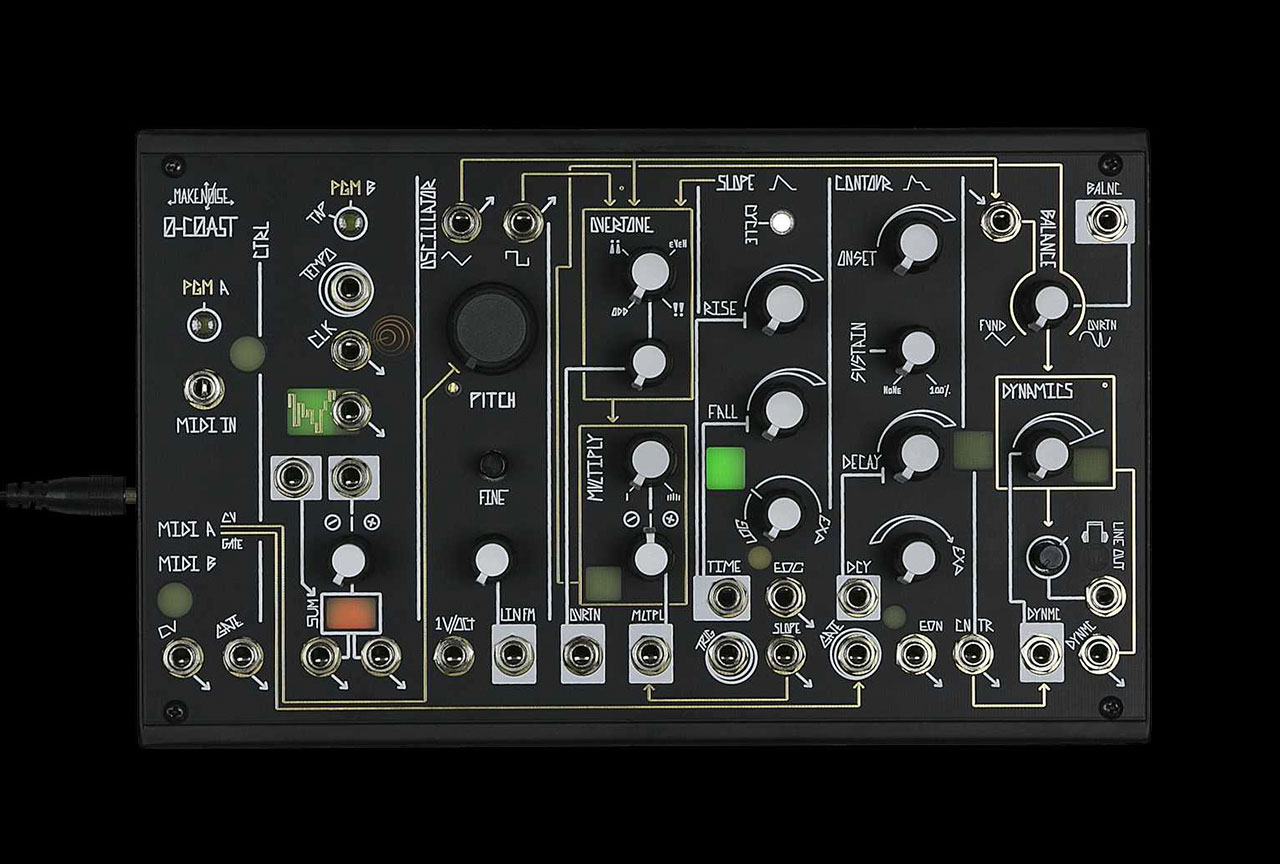- In the world of synthesisers, design paradigms have traditionally been funnelled into one of two categories: West or East Coast. West Coast refers to instruments like those produced by San Francisco's Don Buchla, which favoured additive synthesis and experimentation, rather than the traditional subtractive method made famous by Buchla's East Coast counterpart, Bob Moog. This dichotomy lives on in the world of modern modular synthesisers, where modules and artists continue to find a place on either side of the imaginary fence. But the distinction is based more on style than geography. One example of this is the Eurorack specialists at Make Noise. They're headquartered in the town that Bob Moog once called home (Asheville, NC), but their modules have typically followed the non-traditional dynamic of the West Coast school. They released their first ever desktop unit in June with the goal of bridging the gap between the two schools of thought, hence the name 0-COAST.
When the 0-COAST was introduced at this year's NAMM conference, Internet forums were abuzz with speculation about whether it was truly a desktop unit or a Eurorack module in a desktop case. Many existing Eurorack users no doubt had hopes of integrating the 0-COAST into their rack but the final dimensions of 5.5 x 9 inches proved to be too large. Make Noise eventually confirmed that this was a true desktop unit designed to provide a mix of portability and flexibility. The former of these two goals was partly achieved by the added length, which facilitated a much slimmer profile (.75 inches deep) than would have otherwise been possible.
At first glance, the 0-COAST's controls may seem a bit mystifying. But most of the usual elements you'd expect from a desktop synthesizer are there, albeit with some of the artistic flair typical of Make Noise units. While there is no shortage of patch points on the unit (27 in total), the critical signal path is connected internally by default—or "normalled"—so you don't have to set up multiple patch cords just to make a sound. All you need is to plug a MIDI source into the mini jack with the provided adapter and away you go. Like most analogue synths, incoming MIDI notes are split into pitch and gate signals. In the case of the 0-COAST, they're sent to the oscillator and contour shaper respectively. This oscillator is a stripped down version of the Make Noise DPO, a popular dual West Coast-style VCO module that offers a wide range of timbres through FM and wavefolding. The contour shaper on the other hand can essentially be considered an amp envelope. Its design was inspired by the loudness contour circuit of the original East Coast machine, the Minimoog.
This meeting of East and West in the oscillator and contour sections is likely one of the inspirations behind the "no coast" philosophy coined by the folks at Make Noise. In practice however, there's one foundational East Coast element that feels conspicuously absent: a filter. But that's not to say there aren't ways of taming the frequency content of the signal generated by the 0-COAST. There's the Balance knob, which lets you crossfade between the fundamental frequency and the partials added with the oscillator wavefolder. Also, the Dynamics knob simultaneously reduces high frequencies and volume in a way similar to the Buchla 292 Low Pass Gate. But ultimately, neither of these is a true replacement for a traditional filter. I expect many users would run the 0-COAST into another machine, as I did in my tests with an Oberheim SEM.
Sitting alongside the Contour section, you'll find another envelope generator called Slope. This is set by default to modulate controls in the wavefolder section of the 0-COAST. Without having a manual in hand, it took me a while to figure out that there is no normalled way to trigger this envelope with incoming MIDI—you have to patch something like the Contour's EON (end of onset) output to the trigger input to do the job. There's another way to trigger this without patch cords though: an LED labeled Cycle at the top of the Slope section also doubles as a button. When pushed, the Slope envelope is triggered repeatedly at a rate defined by the Rise and Fall settings. Both the Slope and Contour envelopes have knobs to fade between exponential and linear modes, while Slope can also push into logarithmic territory. As one would expect of any modular unit worth its salt, you can route either envelope to any available control voltage input. The 0-COAST provides a handy CV processing section borrowed from their famous Maths module to make these types of routings even more powerful.
After testing, I came away surprised by the scope of possibilities available in such a small package. Just in the analogue domain, there is ample opportunity to create wild generative sequences and evolving drones without any MIDI input at all. What's more, you can enable a flexible internal arpeggiator or route a MIDI CC or modwheel to any CV input, making 0-COAST compatible in both live and studio contexts. If you can get past the fact that it won't fit into your existing modular rack and the lack of a traditional filter, the 0-COAST is a great way to incorporate the unique Make Noise additive synthesis signature to your productions.
Ratings /
Sound: 4.2
Cost: 4.4
Ease of use: 3.9
Versatility: 4.2
Build quality: 4.4
 Sitting alongside the Contour section, you'll find another envelope generator called Slope. This is set by default to modulate controls in the wavefolder section of the 0-COAST. Without having a manual in hand, it took me a while to figure out that there is no normalled way to trigger this envelope with incoming MIDI—you have to patch something like the Contour's EON (end of onset) output to the trigger input to do the job. There's another way to trigger this without patch cords though: an LED labeled Cycle at the top of the Slope section also doubles as a button. When pushed, the Slope envelope is triggered repeatedly at a rate defined by the Rise and Fall settings. Both the Slope and Contour envelopes have knobs to fade between exponential and linear modes, while Slope can also push into logarithmic territory. As one would expect of any modular unit worth its salt, you can route either envelope to any available control voltage input. The 0-COAST provides a handy CV processing section borrowed from their famous Maths module to make these types of routings even more powerful. After testing, I came away surprised by the scope of possibilities available in such a small package. Just in the analogue domain, there is ample opportunity to create wild generative sequences and evolving drones without any MIDI input at all. What's more, you can enable a flexible internal arpeggiator or route a MIDI CC or modwheel to any CV input, making 0-COAST compatible in both live and studio contexts. If you can get past the fact that it won't fit into your existing modular rack and the lack of a traditional filter, the 0-COAST is a great way to incorporate the unique Make Noise additive synthesis signature to your productions. Ratings / Sound: 4.2 Cost: 4.4 Ease of use: 3.9 Versatility: 4.2 Build quality: 4.4
Sitting alongside the Contour section, you'll find another envelope generator called Slope. This is set by default to modulate controls in the wavefolder section of the 0-COAST. Without having a manual in hand, it took me a while to figure out that there is no normalled way to trigger this envelope with incoming MIDI—you have to patch something like the Contour's EON (end of onset) output to the trigger input to do the job. There's another way to trigger this without patch cords though: an LED labeled Cycle at the top of the Slope section also doubles as a button. When pushed, the Slope envelope is triggered repeatedly at a rate defined by the Rise and Fall settings. Both the Slope and Contour envelopes have knobs to fade between exponential and linear modes, while Slope can also push into logarithmic territory. As one would expect of any modular unit worth its salt, you can route either envelope to any available control voltage input. The 0-COAST provides a handy CV processing section borrowed from their famous Maths module to make these types of routings even more powerful. After testing, I came away surprised by the scope of possibilities available in such a small package. Just in the analogue domain, there is ample opportunity to create wild generative sequences and evolving drones without any MIDI input at all. What's more, you can enable a flexible internal arpeggiator or route a MIDI CC or modwheel to any CV input, making 0-COAST compatible in both live and studio contexts. If you can get past the fact that it won't fit into your existing modular rack and the lack of a traditional filter, the 0-COAST is a great way to incorporate the unique Make Noise additive synthesis signature to your productions. Ratings / Sound: 4.2 Cost: 4.4 Ease of use: 3.9 Versatility: 4.2 Build quality: 4.4